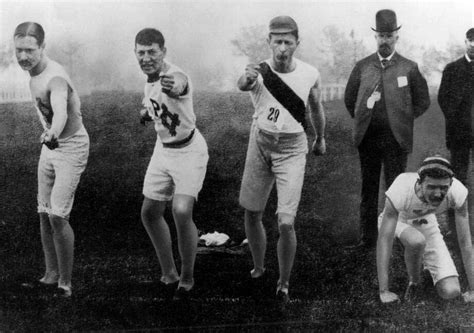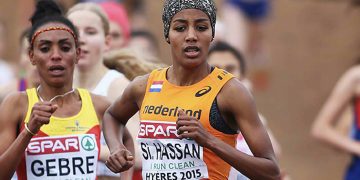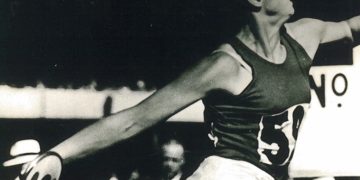Walt Murphy is one of the finest track geeks that I know. Walt does #ThisDayinTrack&FieldHistory, an excellent daily service that provides true geek stories about our sport. You can check out the service for FREE with a free one-month trial subscription! (email: WaltMurphy44@gmail.com ) for the entire daily service. We will post a few historic moments each day, beginning February 1, 2024.
This Day in Track & Field-May 9
RelatedPosts
(c)Copyright 2024-all rights reserved. It may not be reprinted or retransmitted without permission.
By Walt Murphy’s News and Results Service (wmurphy25@aol.com), used with permission.
This Day in Track & Field–May 12
1888–Yale’s Charles Sherrill is credited with becoming the first man to use the “crouching” start in a sprint race (at least in the U.S.–see below). Sherrill won the 100y and 220y at a meet sponsored by the Rockaway Hunting Club in Cedarhurst, Long Island.
In addition to winning 7 IC4A sprint titles in the late 1880s (4-100y/1887-1890, 3-220y/1888-1890), Sherrill was also the 1887 U.S. Champion in the 100-yard dash.
In an era when eligibility restrictions were fewer, Sherrill also finished second in the IC4A 100 in 1886. In 1894, he organized the first international collegiate track meet, a match between Yale and Oxford. Sherrill went on to have a distinguished career as a lawyer, a U.S. ambassador, and a pivotal member of the International Olympic Committee.
Sherrill reportedly learned the new starting technique from famed coach Mike Murphy, who observed runners such as New Zealand’s Bobby MacDonald using the innovative style on the professional circuit in Australia and New Zealand.
http://en.wikipedia.org/wiki/Charles_H._Sherrill_(ambassador)
(For Subscribers) NY Times Obituary(1936): https://timesmachine.nytimes.com/timesmachine/1936/06/26/87953037.html?pageNumber=19
Murphy: https://archives.upenn.edu/exhibits/penn-people/biography/michael-c-murphy/
1924—Former BYU Cougar Clint Larsen cleared 6-9 ½ (2.07m) in an exhibition High Jump in Magna, Utah. He had earlier cleared 6-7 7/8 (2.02+) in an unofficial meet in 1917. The World Record at the time of both jumps was 6-7 5/16 (2.01+), but neither of Larsen’s marks was ratified by the IAAF.

1928—Stanford’s Emerson “Bud” Spencer set a World Record 47.0 for 400 meters at the Pacific AAU meet on his home track. The previous record of 47.6 was set by Great Britain’s Eric Liddell (“Chariots of Fire”) in 1924.
Spencer won the NCAA title the following month and was a member of the U.S. team that won the 4×400 (and set a World Record) at the Olympics in Amsterdam.
Hugo “Swede” Leistner, the 1925 NCAA Champion while at Stanford, set an American Record of 14.8 in the 120y-hurdles.
WR Progression: http://en.wikipedia.org/wiki/Men’s_400_metres_world_record_progression
https://www.olympedia.org/athletes/79077
Wiki Bio: https://en.wikipedia.org/wiki/Emerson_Spencer
Leistner: https://en.wikipedia.org/wiki/Hugo_Leistner
1956–Two sporting legends tied for first place in the High Jump at the West Coast Relays in Fresno, California. Charlie Dumas, who would become history’s first 7-footer the following month at the U.S. Olympic Trials, and a young basketball player named Bill Russell cleared 6-9 ¼ (2.06+).
Cordner Nelson wrote of Russell in T&F News at the time, “…a good coach would have him clearing 7’-3” (2.21) or better in a few months…if (the 6’-10”[2.08+]) Russell wanted to make an effort”. Both would win gold medals at the Melbourne Olympics later in the year, Dumas in the High Jump and Russell, who had led the University of San Francisco to its 2nd straight NCAA title in March as a key member of the winning U.S. basketball team.
Russell was ranked #7 in the world in the High Jump in 1956 by T&F News (Dumas was #1), but gave up the opportunity for further glory in the event to pursue a career in the NBA. I guess the Hall-of-Famer made the right decision, leading the Boston Celtics to 11 NBA titles in 13 seasons.
Dumas HOF Bio: https://www.usatf.org/athlete-bios/charles-dumas
1962—The University of Oregon, which has produced more than 30 sub-4-minute milers over the years, used three of them here as they ran 16:08.9 (ratified as 16:09.0) in the 4-Mile Relay at the West Coast Relays in Fresno, California, to shatter the previous World Record of 16:23.8, which was set by a Peter Snell-anchored New Zealand team the previous year.
Leading off for the Ducks was Archie San Romani, Jr., who ran 4:03.5 and would later run 3.57.6 in 1964. He was followed by Canadian Vic Reeve (4:05.4), the only one of the four who never broke four, and Keith Forman (4:02.3), who ran 3:58.3 later in the year. With Dyrol Burleson, the American Record holder in the mile (3:57.6) and 1960 Olympic finalist (6th) on the anchor, a new record was a certainty, but “Burly” raced as if every second counted and finished off Oregon’s great run with an anchor split of 3:57.7. Burleson made his 2nd Olympic final in 1964, finishing 5th in Tokyo.
New Zealand regained the WR when it ran 16:02.8 in 1972, but Oregon’s mark stood as the Collegiate Record for 37 years until Arkansas ran 16:07.96 at the 1999 Penn Relays. Michigan improved the record to 16:04.54 at the 2005 Penn Relays, but the Ducks took back the record when they ran 16:03.24 in 2009. The CR was taken to another level this year when Villanova (15:51.91), Virginia (15:52.30), and Georgetown (15:52.56) broke through the 16-minute barrier at the Penn Relays.
Burleson was inducted into the U.S. Hall of Fame in December 2010. https://www.runnerspace.com/gprofile.php?mgroup_id=45597&do=news&news_id=204607






















